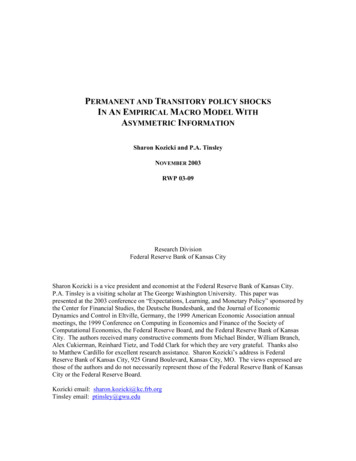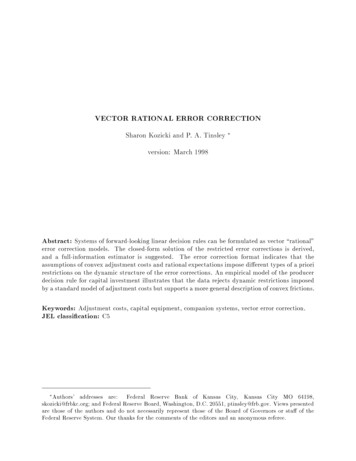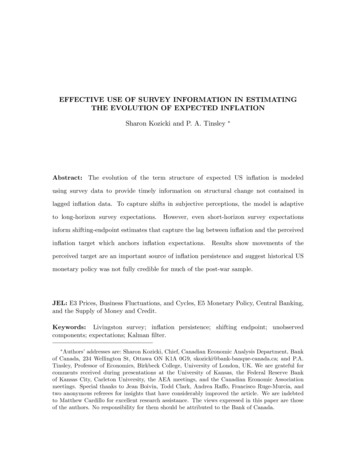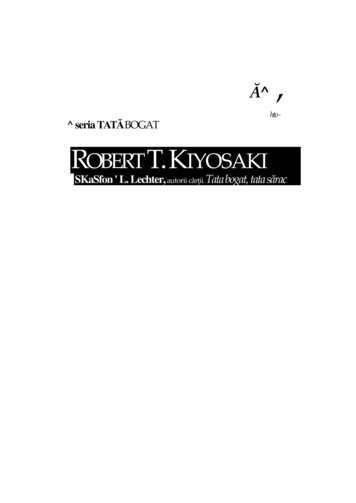
Transcription
PERMANENT AND TRANSITORY POLICY SHOCKSIN AN EMPIRICAL MACRO MODEL WITHASYMMETRIC INFORMATIONSharon Kozicki and P.A. TinsleyNOVEMBER 2003RWP 03-09Research DivisionFederal Reserve Bank of Kansas CitySharon Kozicki is a vice president and economist at the Federal Reserve Bank of Kansas City.P.A. Tinsley is a visiting scholar at The George Washington University. This paper waspresented at the 2003 conference on “Expectations, Learning, and Monetary Policy” sponsored bythe Center for Financial Studies, the Deutsche Bundesbank, and the Journal of EconomicDynamics and Control in Eltville, Germany, the 1999 American Economic Association annualmeetings, the 1999 Conference on Computing in Economics and Finance of the Society ofComputational Economics, the Federal Reserve Board, and the Federal Reserve Bank of KansasCity. The authors received many constructive comments from Michael Binder, William Branch,Alex Cukierman, Reinhard Tietz, and Todd Clark for which they are very grateful. Thanks alsoto Matthew Cardillo for excellent research assistance. Sharon Kozicki’s address is FederalReserve Bank of Kansas City, 925 Grand Boulevard, Kansas City, MO. The views expressed arethose of the authors and do not necessarily represent those of the Federal Reserve Bank of KansasCity or the Federal Reserve Board.Kozicki email: sharon.kozicki@kc.frb.orgTinsley email: ptinsley@gwu.edu
AbstractDespite a large literature documenting that the efficacy of monetary policydepends on how inflation expectations are anchored, many monetary policy modelsassume: (1) the inflation target of monetary policy is constant; and, (2) the inflationtarget is known by all economic agents. This paper proposes an empirical specificationwith two policy shocks: permanent changes to the inflation target and transitoryperturbations of the short-term real rate. The public sector cannot correctly distinguishbetween these two shocks and, under incomplete learning, private perceptions of theinflation target will not equal the true target. The paper shows how imperfect policycredibility can affect economic responses to structural shocks, including transition to anew inflation target—a question that cannot be addressed by many commonly usedempirical and theoretical models. In contrast to models where all monetary policyactions are transient, the proposed specification implies that sizable movements inhistorical bond yields and inflation are attributable to perceptions of permanent shocks intarget inflation.JEL classification: E52, D82, D83, E43Keywords: transmission mechanism, learning, policy credibility, time-varying naturalrate, shifting endpoint, inflation target, term structure of interest rates
1IntroductionMany models that are used to evaluate monetary policy assume, either explicitly orimplicitly, that (1) the inflation target of monetary policy is constant over the periodbeing analyzed; and, (2) the inflation target is known by all economic agents. Becausethe actual and perceived inflation targets are equal and fixed, long-horizon expectationsare independent of short-run policy in such models.1 Consequently, all monetary policyactions are transient, and monetary policy appears to contribute only modestly to postwarfluctuations in bond rates and economic activity.The assumption that the inflation target is fully credible is surprisingly prevalent inrecent studies that examine historical policy or evaluate alternative policies. The literaturethat evaluates policy alternatives under a constant and credible inflation target is vast.Optimizing models used to evaluate alternative monetary policies, such as those reviewed inTaylor (1999), generally assume a constant inflation target is common knowledge. Likewise,standard atheoretical empirical analyses of policy effects implicitly assume a fixed policytarget or stationary nominal anchor. As noted by Kozicki and Tinsley (2001a), VARscontaining the levels of inflation and nominal interest rates imply constant and knownnatural rates for those variables.The traditional assumption that policy objectives were known to the private sectorwas accompanied in early studies by an emphasis on the real effects of unanticipatedchanges in monetary policy, such as Lucas (1973) and Sargent and Wallace (1976). Becauseimperfectly observed policy is equivalent to unanticipated policy, several early studiesnoted that monetary policy could have larger real effects in learning or filtering transitionsbetween persistent shifts in policy, such as Taylor (1980), Meyer and Webster (1982), and1The conclusion that long-run expectations are independent of short-run policy presumes that the policybeing followed is consistent with the goals of policy. For example, a Taylor-type (1993) interest rate rulewith an explicit numerical inflation target that doesnt satisfy the Taylor principle would generally lead toexplosive inflation and explosive private-sector inflation forecasts. Such a policy rule would be inconsistentwith the inflation target.1
Cukierman and Meltzer (1986). In subsequent literature, the introduction of nominalfrictions permitted real effects of expected monetary policy.By contrast with earlieremphasis on the strength of unanticipated policy under learning, more recent papers indicatethat expected policy effects can be significantly attenuated if private agents are not instantlyaware of shifts in policy targets, such as the lengthy learning lags estimated in Kozicki andTinsley (2001a, 2001b).Accounting for imperfect policy credibility and learning is particularly important in thecontext of the nonstationary behavior of postwar U.S. inflation. Regime-switching modelsfit to U.S. inflation include, Brunner (1991), Evans and Wachtel (1993), Evans and Lewis(1995), and Garcia and Perron (1996). Levin and Piger (2003) present evidence for aone-time break in the mean inflation rates of twelve industrial countries, including the U.S.,over a 1984-2002 sample. Relaxing the assumption of a fixed number of regimes and usingsamples from the 1960s through the 1990s, Kozicki and Tinsley (2001a, 2001b, and 2002)provide empirical evidence on nonstationary movements in the mean of inflation and suggestthese reflect shifts in private agent perceptions of the policy target for inflation.Of course, evidence of mean shifts in the inflation process may be consistent with anunknown, but fixed, inflation target and time-varying perceptions. For example, Orphanidesand Williams (2003) illustrate that the perceived inflation target estimated by learningagents may increase in response to unfavorable inflation shocks, even if the true target isinvariant. The divergence of perceived and actual inflation targets is larger for policiesthat place more emphasis on real output stability, providing one interpretation of highand rising levels of inflation in the 1970s. An alternative historical interpretation includesthe prospect that the effective inflation target drifted higher in the 1970s, in part due topartial accommodation of sizeable supply shocks, followed in the 1980s by rapid reductionsin the true policy target but much slower declines in the perceived inflation target. Whilethe latter view is more consistent with econometric specifications used in this paper, both2
interpretations share the common assumptions of asymmetric policy information and ofsignificant deviations of private sector long-run inflation forecasts from the true inflationtarget.Because shifts in the perceived inflation target do not always appear to coincide withpossible shifts in the inflation target of the monetary authority, asymmetric information onthe part of private sector agents and the monetary authority seems more plausible than thestandard assumption of full information. In this paper, such deviations of the perceivedtarget from the true target provide evidence of imperfect policy credibility, where crediblepolicy is defined as the equivalence of the natural rate of private sector inflation forecastswith the inflation target of the monetary authority.Recent macro models with shifting policy regimes include the atheoretic empirical modelof Cogley and Sargent (2003), the calibrated dynamic stochastic general equilibrium modelsof Erceg and Levin (2003) and Andolfatto and Gomme (2003), and Bayesian estimates ofthe DSGE models in Schorfheide (2003). Similar to learning specifications in the last twocitations, private agent learning in the current paper is based on agent responses to theprediction error of the short-term interest rate controlled by monetary policy.This paper reexamines evidence on the monetary transmission mechanism using a smallempirical model of the U.S. economy. The model specification admits imperfect policycredibility by relaxing the standard assumptions of full information and a constant inflationtarget. Monetary policy is summarized by a policy rule with the federal funds rate smoothlyadjusted in response to cyclical movements in economic activity, deviations of inflation fromthe inflation target, inflation target shifts, and transitory policy shocks. Unlike typicalempirical models with a single policy shock, the model in this paper includes two types ofpolicy shocks: permanent shifts to the inflation target and transitory perturbations of thefederal funds rate. Because agents do not observe the true target, they cannot distinguishpermanent and transitory policy shocks in the short run.3
In the model, the inflation goal of policy is assumed only to be known by the monetaryauthority, although the observable policy instrument provides noisy information about thetarget. Private sector agents must form perceptions of the inflation goal of policy and theseperceptions influence nominal price setting. The model specification admits a possiblyshifting inflation target of monetary policy as well as a perceived inflation target that alsomay vary over time. This framework can apply to countries with announced inflation targetsas well as to those without, since announced targets may not be fully credible.Simulations of the model illustrate how imperfect policy credibility can affect transitionto a new inflation target, a question that cannot be addressed by many commonly usedempirical and theoretical models. In contrast to models where all monetary policy actionsare transient, the model generates sizable monetary policy contributions to historicalfluctuations in inflation and bond yields attributable to permanent target shocks.Aconsequence of the estimated learning structure is that the perceived inflation target remainselevated well into the 1980s, holding up bond rates long after the inflation target andinflation have retreated.Taylor (1980) and Meyer and Webster (1982) examine the implications of a permanentpolicy shock in models with a money growth rule and learning behavior on the part of theprivate sector. These papers examined the behavior of inflation without references to actualor perceived inflation targets or long-term interest rates. Effects of changes in perceivedinflation targets on long-term bond rates are analyzed in Fuhrer (1996), Huh and Lansing(1998), and Kozicki and Tinsley (2001a, 2001b). Whereas Fuhrer’s analysis assumes shiftsin policy regimes are instantly known to private agents, the remaining studies incorporateasymmetric information assumptions. The current paper provides explicit contrasts betweenempirical estimates of the time-varying inflation target and private sector perceptions of theinflation target.Following the seminal work of Sargent (1993) and Evans and Honkapohja (2001), models4
of learning by agents often specify that agent expectations are generated by recursive leastsquares (RLS) estimates of linear forecast functions (perceived laws of motion).RLSlearning is a natural assumption for models that are known to have fixed coefficients.However, RLS learning is likely to be less relevant for economies with time-varying structures(including the case of shifting inflation targets).Alternative learning methods for time-varying shifts include change point models,explored by Kozicki and Tinsley (2001a), and variants of bounded memory learning, suchas rolling sample estimation or constant gain estimation, illustrated in the simulationsof Orphanides and Williams (2003). Other examples of constant gain learning in thecontext of rare permanent real shocks are Bullard and Duffy (2003) and Bullard and Eusepi(2003). As noted in these studies, benefits of constant gain learning include both recursivetractability and sensitivity to recent observations that incorporate the current shifts of theunderlying economic structure. Although bounded memory learning can converge to arational expectations equilibrium in a deterministic model, convergence will not occur inmodels with stochastic shocks, Evans and Honkapohja (2003). Consequently, an offsettingcost of constant gain learning, even if shifts are infrequent, is that the economy will notconverge to the new rational expectations equilibrium path but to an ergodic distributionabout the REE. Intuitively, smaller rolling sample spans or larger constant gains providea tradeoff between faster recognition of new shifts and higher “excess” volatility in steadystates.In this paper, implications for the transmission mechanism of possibly shifting policygoals, imperfect policy credibility (or asymmetric information), and private sector learningare examined by comparing the properties of two empirical models of the U.S. economy:a model with time-varying policy goals and learning; and, a model with similar dynamicstructure but with a constant and credible inflation target. Many of the studies cited earlieraddress asymmetric information and learning issues using analytical or calibrated models.5
By contrast, the analysis of this paper is based on an estimated empirical model witha shifting inflation target. Time variation of the inflation target incorporates exogenousand endogenous sources, and is not limited to a small number of policy regimes. Additionalcontributions of the paper include a model specification with both permanent and transitorypolicy shocks, explicit estimation of the implicit actual and perceived inflation target series,and dynamic analysis linking private sector perceptions of target shocks to the behavior oflong-term interest rates.The next section introduces the empirical model with a time-varying inflation target,asymmetric information, and learning.Section 3 discusses estimation procedures.Estimation results are presented for both the time-varying target model and a modelthat assumes the inflation target is constant and credible. Kalman filter estimates ofthe perceived inflation target and the inflation target obtained from the time-varyingmodel are presented. Section 4 compares the dynamic responses of the two systems totransitory structural shocks and explores responses to target and expectations shocks inthe time-varying target model. Three important results are obtained. First, in general,responses in the time-varying target model tend to be smaller and less persistent than thosein the constant target model. Second, in contrast to the transitory effects obtained withthe constant-target model, aggregate supply shocks have permanent effects on inflation andnominal interest rates in the time-varying-target model as a consequence of partial policyaccommodation of supply shocks. Third, the “price puzzle” in the response of inflation toa transitory policy shock disappears in the model with a time-varying target and learning.Section 5 explores the role of the speed of learning in the time-varying target model. Thespeed of learning is shown to influence the volatility and persistence of responses to policyshocks. As the speed of learning increases, i.e., with an improvement in credibility, real costsassociated with the transition to a new inflation regime are smaller. However, faster learningalso implies greater volatility in inflation target perceptions in response to transitory policy6
shocks.2The modelAs demonstrated in Kozicki and Tinsley (2002), shifts in the perceived inflation target,imperfect policy credibility, and time-variation in the persistence of inflation appear to beimportant empirical properties of U.S. inflation. The motivation of the current paper is tospecify a simple dynamic macro model that can generate these key empirical features.Two issues influenced the selection of a model with essentially a VAR-like structure.First, good empirical fit was seen as essential to providing a realistic assessment of theeconomic significance of shifting inflation targets and asymmetric information. Second,replication of observed dynamic interactions is important for examining policy transmissionand long-run forecasts.The selected specification is a bit more general than a standard VAR. As with traditionalmodels, dynamic interactions among deviations of variables from their natural rates arecaptured in a linear time-series structure. However, whereas standard models implicitlyassume that the natural rates of variables are constant and known, the current model isaugmented to allow for shifts of the inflation target and asymmetric policy information.2Kozicki and Tinsley (2002) estimated a perceived inflation target series from a similarVAR-like model with shifting endpoints, but did not distinguish between target shifts andperceived target shifts.The asymmetric information assumption implies that the inflation target is not knownby the private sector.3 Even if the target were to be announced, the model assumes that2The term “natural rate” is used to refer to the long-run equilibrium or attractor of a variable. Theterm “anchor” appears to be traditionally used in literature to denote a nominal natural rate, and the terms“steady-state” and “mean” often imply constants.3The source of asymmetric information in this study is lack of knowledge on the part of the privatesector about the level and evolution of the inflation target, and about transitory and permanent policyshocks. Other formulations of asymmetric information include private sector uncertainty about policymakerpreferences over real activity versus inflation as in Cukierman and Meltzer (1986) and Tetlow and von zurMuehlen (2001), and different models of the transmission mechanism or other aspects of model specification7
such announcements need not be credible. Consequently, the private sector must formbeliefs about the inflation target. The model is augmented to capture learning behavior onthe part of the private sector and includes a time-varying perceived inflation target thatwill tend to differ from the possibly time-varying inflation target.The model includes expressions for the dynamics of four variables, the output gap (yt ),inflation (πt ), the federal funds rate (rt ), and a long-term interest rate (Rt ), and expressionsthat describe the evolution of time-variation, if any, in natural rates. A long-term interestrate has been included so that policy transmission issues associated with long-horizonexpectations can be better addressed. In particular, long-term interest rates depend onprivate sector long-horizon forecasts of inflation, and those forecasts will be influenced inthe short-run by shifts in the perceived inflation target.In model expressions, variables are expressed as deviations from natural rates. Thenatural rate of the output gap is assumed to be constant (ȳ) and equal to zero, althoughempirical estimates may differ from zero over finite samples. The natural rate of inflationequals the perceived inflation target (πP (t)), which may be time varying. The naturalreal rate is assumed to be constant (r̄). The perceived inflation target, πP (t), appears inthe natural rates of both short-term and long-term nominal interest rates as it anchorsthe expected inflation component of nominal interest rates. Thus, the natural rate of thelong-term nominal interest rate is equal to the sum of the natural real rate, the termpremium natural rate (θ̄) which is assumed to be constant, and the perceived inflationtarget: r̄ θ̄ πP (t). The natural rate of the federal funds rate is the sum of the naturalreal rate and the perceived inflation target (r̄ πP (t)). The policy equation also capturesthe federal funds rate response to the deviation of recent inflation from the policy targetfor inflation.Expressions for the output gap, inflation, and the long-term interest rate are similaremployed by the private sector and policymakers.8
to VAR equations with lags of the output gap, inflation, the federal funds rate, and thelong-term interest rate included in each. Monetary policy is modeled using an estimatedTaylor (1993) rule with smoothing. Smoothing refers to the appearance of the laggedfunds rate in the policy rule. The lagged funds rate is often interpreted as capturingsmoothing behavior on the part of policymakers who may prefer to act gradually in thepresence of uncertainties about the structure of the economy. Gradualism may also reducefinancial market activity and increase economic responses to policy actions by magnifyingthe response of other market interest rates to policy actions. See, for example, the discussionin Amato and Laubach (1999) and English, Nelson, and Sack (2003). Empirical estimates ofTaylor rules with smoothing are provided in Kozicki (1999) and Sack and Wieland (2000).The policy rule specifies that the deviation of the federal funds rate from its natural rateis determined by policy responses to the output gap, the deviation of inflation over theprevious four quarters (π̄t,4 ) from the inflation target, a lagged funds rate deviation tocapture policy smoothing, and a transitory policy shock (ur,t ):rt r̄ πP (t) γy (yt ȳ) γπ (π̄t,4 πT (t)) ρ(rt 1 r̄ πP (t)) ur,twhere π̄t,4 (1)P3i 0 πt i .Structural shocks to aggregate demand, aggregate supply, the funds rate (a transientpolicy shock), and the term premium are identified by assuming a recursive causal orderingwith the output gap ordered first, followed by inflation, the federal funds rate, and thelong-term interest rate. Thus, the assumed causal ordering implies that long-term interestrates respond contemporaneously to the aggregate demand, aggregate supply, transitorypolicy, and term premium shocks. The residual in the output gap equation is identified asan aggregate demand shock.The inflation equation is a reduced-form Phillips curve.Inflation may respondcontemporaneously to the aggregate demand shock, explaining a possible correlation9
between the output gap equation residual and the inflation equation residual. Inflationalso responds to an aggregate supply (cost push) shock. A notable feature of the reducedform Phillips curve specification is that the sum of coefficients on lags of inflation deviationsare not constrained to unity. However, because inflation only appears in the Phillips curve asthe deviation from the perceived target, the expression does not exhibit a long-run tradeoffbetween inflation and the output gap.A long-run tradeoff is absent because the policy rule in the model is such that positiveexcess demand can persist only if the inflation target is allowed to increase. The learningstructure in the model is such that an increase in the target is eventually incorporatedinto an increase in the perceived target, and consequently to inflation.4 The policy rulestructure assumes that monetary policy responds contemporaneously to the output gapand inflation, and thus to the aggregate demand and aggregate supply shocks. The fundsrate also responds to the transitory policy shock (a liquidity supply shock).The remaining equations of the model describe the evolution of the inflation targetseries and the perceived target series. The inflation target follows a martingale process sothat changes in the inflation target series are not forecastable. The inflation target shiftswith policy accommodation (if any) of aggregate supply shocks (uS,t ), with deterministicregime change (in the early years of Volker’s chairmanship of the Federal Reserve), or withexogenous permanent policy shocks (uT,t ):πT (t 1) πT (t) ηd79 82 cST uS,t uT,t .(2)Regime change to bring inflation down following the appointment of Volker as chairman ofthe Federal Reserve is captured deterministically through the dummy variable d79 82 , setto one for the period 1979Q4 through 1982Q4 and zero at other times. As captured by4Given the structure of the model, the monetary authority would be able to maintain permanent excessdemand (i.e., output above potential) by allowing the inflation target and inflation to continue to increasewithout bound.10
the binary dummy, the inflation target was gradually changed by η in each quarter of the1979Q4 through 1982Q4 interval. A competing description is that the target was completelyadjusted in one quarter, 1979Q4, but this provides a poor estimate of η. Increasing theperiod over which the target change occurred reduces the standard error of the estimateof η. The 1979Q4 to 1982Q4 interval is also a period when U.S. monetary policy targetedmeasures of the money supply and nonborrowed reserves, and there were several adjustmentsof targets and operating procedures.Exogenous policy shocks may proxy for changes in the degree of conservatism of theFederal Open Market Committee (FOMC), at least to the extent that this accompanies achange in the composition of the FOMC, and importantly, the Chairman. Other possibleexplanations for target changes include partial accommodation of changing expectations ofthe private sector, as in Bullard and Cho (2002), or partial accommodation of movementsin inflation, as in Gürkaynak, Sack, and Swanson (2003). The former is inconsistent withthe target leading the perceived target, as was likely the case in the Volker disinflation.The latter might be seen as a reduced-form variant of partial accommodation of aggregatesupply shocks as specified in this paper.The evolution of the perceived inflation target incorporates learning behavior aboutthe target on the part of the private sector. Several approaches to modeling learningbehavior that could be used to close the model include recursive least squares learning,Markov switching, changepoint learning, and constant gain learning. In models with a fixedstructure, recursive least squares estimates of parameters can converge to the true parametervalues. However, recursive least squares loses its appeal in models with structural changeas distant past observations are weighted equally to recent observations. Markov switchingmodels are effective in specifications where there is advance knowledge of the number ofregimes. However, empirical implementations do not accommodate regimes that have notyet occurred (with no data points in a regime, it is impossible to estimate the parameters11
that characterize the regime).Kozicki and Tinsley (2001a and 2001b) use changepoint learning in a model with possiblymultiple regimes when the number of regimes is not predetermined. Learning about targetshifts is modeled by assuming agents use Andrews (1993) breakpoint tests to detect meanshifts in inflation. Learning lags are captured by dating expectations shifts according tothe time at which agents could statistically detect mean shifts, which necessarily lags theactual occurrence of mean shifts. Heterogeneity of agents is captured using alternativeimplementations of the test based on the number of new observations collected prior toretesting. Kozicki and Tinsley (2001a) use multinominal logit aggregation of heterogeneouslearning that allows weights on different breakpoint-test implementations to depend onrecent performance. An advantage of changepoint learning is that it will converge in theabsence of structural shifts. A disadvantage is that testing for change points is not amenableto recursive formulations.Constant gain learning is similar to recursive least squares but gives more weightto more recent observations to capture effects of structural shifts.However, in theabsence of shifts, constant gain learning will generate noisy estimates of parameters(natural rates) as disturbances to observable data series will be mapped into perceptions.Although changepoint learning and constant gain learning have very different properties,Kozicki and Tinsley (2001b) found that inflation-based constant gain learning in whichthe perceived target is updated in the direction of recent inflation (πP (t 1) πP (t) κ(πt πP (t))) approximated the estimated perceived inflation target constructed usingchangepoint-learning with heterogeneous agents.This paper uses constant gain updating rules to model learning about structural shiftsin the inflation target. The benefits of this approach include the potential for capturingpermanent structural shifts, the adaptability to recursive formulations, and the absence ofsharp prior requirements, such as advance knowledge of the number of policy regimes. The12
principal cost is the excess noise in estimated perceptions that occurs in the absence ofstructural shifts.The constant-gain learning algorithm that was chosen differs from the inflation-basedalgorithm examined in Kozicki and Tinsley (2001b). Implicitly, inflation-based constantgain learning assumes considerable ignorance on the part of the private sector about theeconomic structure and requires policy actions to first influence aggregate demand, whichin turn affects inflation, before the perceived target adjusts. However, additional lags in thelearning process are by assumption. Given the structure of the model in the current paper,learning is based on unexpected movements in the funds rate as these are direct, but noisy,measurements of shifts in the inflation target. A funds rate that is higher than expectedmay reflect a permanent reduction in the inflation target or a transient positive policyshock to the funds rate, and vice versa. With policy response-based learning, movemen
Sharon Kozicki's address is Federal Reserve Bank of Kansas City, 925 Grand Boulevard, Kansas City, MO. The views expressed are those of the authors and do not necessarily represent those of the Federal Reserve Bank of Kansas City or the Federal Reserve Board. Kozicki email: sharon.kozicki@kc.frb.org Tinsley email: ptinsley@gwu.edu










